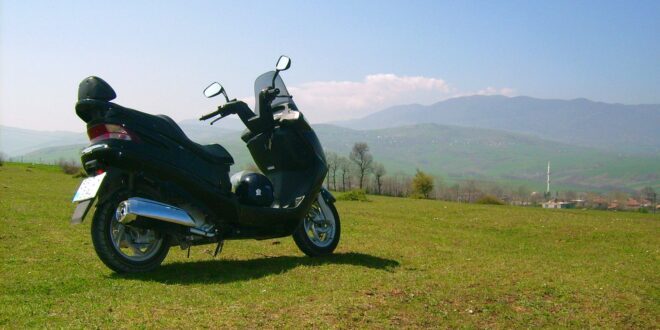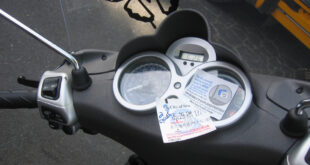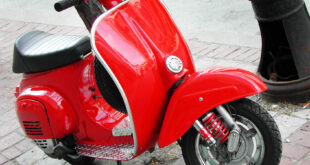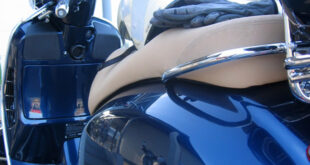When picking the perfect scooter for you, scooter size, engine power, and scooter weight are essential considerations.
Scooter weight affects handling, comfort and safety. A heavy scooter is more challenging to maneuver than a light scooter, both while riding and on the ground. Here are some things to keep in mind while deciding how much scooter you can handle.
How Scooter Weight Affects You
Maneuverability while riding
Heavier scooters require more leaning in turns and are harder to corner. They often have increased braking-distance, which means it takes you longer to stop. But heavy scooters are also less affected by external factors like gusty wind on bridges, making them a more stable ride in certain cases.
Handling on the ground
The heavier a scooter is, the more strength is required to handle it when parking and putting it up on its center stand. If you doubt the importance of easy handling on the ground, try wrestling a 375 lb. Vespa GTS into a parking spot on a hill. (As usual, I speak from highly personal experience!)
Remember that scooters don’t have “reverse” for backing up; if you want to go backwards, you have to push it.
Gas mileage
The weight of a scooter will also affect your gas mileage. In general, lighter scooters tend to get more miles per gallon. For comparison, take two scooters with equal engines: the Genuine Buddy, at 220 lb. averages 90 mpg; while the Vespa LX weighs 242 lb. and gets about 68 mpg.
This difference in mpg doesn’t exactly break the bank when compared with your average SUV, but it’s still a point to consider. (Other factors besides weight also affect the gas mileage of a scooter.)
What Determines Scooter Weight?
Scooters vary wildly in weight. A couple of things influence the weight of a scooter:
Overall body size
In this corner, weighing in at a slight and slender 127 pounds, the diminutive Honda Metropolitan! And in this corner, tipping the scales at a hulking 340 pounds, the massive Vespa GTS. If you want to go super heavyweight, check out the Piaggio MP3, which appears to rival your average sedan in mass.
Engine power
A general rule of thumb: the more powerful the engine, the heavier the scooter.
Metal vs. plastic body construction
A metal-bodied scooter will weigh more than a plastic-bodied scooter of the same size. Plastic is much more common in modern scooters.
Even the Vespas with steel chassis have some plastic panels, like the horncast on the GTS. I discovered this when attempting to cover my scooter with magnetic refrigerator poetry and it wouldn’t stick in some places!
Accessories and bling
Accessories also increase the overall weight of the scooter, especially after-market items like chrome cowl protectors, cargo racks and windscreens.
My Stella’s accessories, including chrome fender guards, legshield crash bars, cowl protectors, extra mirrors, rear rack, spare tire carrier, and passenger seat easily add another 40 pounds to the weight of my scooter. They also add 40 pounds of sparkle, which is worth every ounce!
The Importance of Weight Placement
Where the weight is placed on the scooter, and how well it is balanced, is just as important as the overall mass.
My Vespa GTS, “Aphrodite,” is a big girl – nearly 400 pounds with all her accessories, a full tank of gas and my laptop.
But the Vespa GTS is so flawlessly designed that the scooter feels weightless as soon as you open the throttle. The center of gravity is low and the weight evenly-balanced.
When I bought my topcase (a fancy word for “trunk”), Vespa included weighted chrome tips for my handlebars. These were screwed into my handgrips to re-balance the weight distribution after installing the topcase. The GTS may be loaded down with 40 pounds of accessories, but everything is balanced and evenly-distributed so I barely notice the extra weight.
Contrast this with the Stella scooter and P-series Vespas. My Stella’s center of gravity is much higher than the GTS. Additionally, the engine is located on the right side of the scooter, causing a total imbalance in weight distribution.
You’ll especially notice this when riding behind a Stella or P-series Vespa – you can see the bike tilting to the left slightly as the rider compensates for the imbalance.
After riding my GTS, the Stella feels top-heavy and tippy, even though it’s 100 pounds lighter. I get used to the feeling after a few minutes, but it drives home the point that weight distribution is just as important as total weight.
You’ll also notice the importance of weight placement when you carry cargo – a 25lb. bag of cat litter is much more noticeable perched up on the rear rack than in the compartment under the seat. Like wise if you split a heavy load in half between two saddlebags located low on either side of the scooter.
Before deciding on your perfect scooter, be sure to sit on a few and feel the difference in weight, as well as the distribution of that weight. If you can easily manage the scooter on the ground, you’ll have an easier time handling it while riding.
 Scooter Lust two wheels, one love
Scooter Lust two wheels, one love





Kristen, I’ve got to challenge you on your assertion that metal body scooters are meaningfully heavier than their tupperware counterparts. This is not actually the case.
I too used to assume that the mostly metal Vespas were significantly heavier, but the numbers don’t show that. For example. You compare the 242 lbs of the a metal-chassis Vespa LX-150 to the Genuine Buddy 125’s 220 lbs. Considering that the LX-150 is a little bit bigger than the Buddy, the 22 lb weight difference is a wash. Another 150cc example: the all-metal Stella weighs in at just 240 lbs. The plastic-clad Piaggio Fly 150 weighs in at 247 lbs. All four of these scooters are roughly the same size class and roughly the same overall footprint.
So it’s fair to conclude that the mpg differences between the LX and the Buddy comes down to powerplant and gearing, not curb weight.
Keep in mind that even scooters with plastic body panels still have steel tube frames underneath. The beauty of the Vespa’s all-metal body design is that the steel body doubles as the chassis, giving the bike a rigidity-to-weight ratio that a plastic body scooter simply can’t match. That manufacturing, however, is much more costly, which is the only reason tube-and-plastic scooters are so prevalent.
Also, the engine makes quite a big difference in terms of weight. My Vespa Grantourismo 200L is the exact same scooter as your GTS 250, but the motor weighs nearly 50 lbs less! So it’s not the metal body that makes your GTS heavy, it’s that QUASAR motor, which is able to be bored all the way up to 500 cc.
But all in all, you’ve hit the nail on the head. Center of gravity is far more important than overall weight. It’s also worth noting that wheel size often has more to do with how stable a scooter feels than even its center of gravity. The riding feel of the Aprilia SportCity and its 15″ wheels is completely different from the Vespa GTS on 12″ wheels, even though they share the same powerplant and are roughly the same size.
Nathaniel –
Thanks for sharing your viewpoint on the weight of scooters. The engine size/chassis size/ body material triangle makes it very difficult to pinpoint the exact reason for variance in scooter weight. I think it’s easier to compare the differences among very similiar scooters to highlight the influence of engine size in the overall weight of a scooter. The Vespa GT vs. GTS is a great example since they differ in little besides the engine. (In fact, I chuckle to remember the disucssion I had with some scooterists when I was looking at the GTS who suggested I might want to go with the GT since I’m a girl and might have difficulty shouldering the extra 50 lbs.)
The topic of wheel size is a great one and perhaps worthy of a future article. My experience with varying wheel size is limited; I’ve ridden only on 10 inch and 12 inch wheels. My friend had a Piaggio BV, which had bigger wheels – I believe they were close to 15″ like the Aprilia. It seemed like it would provide a more stable ride – especially on places like draw bridges (my favorite!!!).
Thanks again for your input!